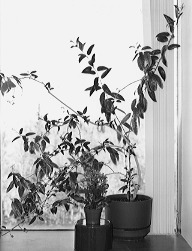
How Long is Your Night?
Finding varieties of spinach and beets that won't bolt. Watching the leaves turn color, even when there hasn't yet been a frost. Trying to get last year's Christmas cactus or poinsettia to bloom. Solving the mystery of who spilled the perfume in the meteorology lab. What do they have in common? The answer is a phenomenon called photoperiodism, which helps plants keep track of when it's time to bloom.
Many plants seem to "know" how long the day is. Depending on the variety, they may refuse to bloom unless the length of day is to their liking. For varieties bred at lower latitudes, this may pose problems for Alaskans, since plants such as spinach and beets often take our long summer days as a signal that they must bloom at once rather than grow the leaves and roots we want. Similar problems arise in late summer with imported perennials, shrubs, and trees, which refuse to prepare for winter dormancy while the days are still as long as they are here in early September. But how do eyeless, clockless, plants know how long the day is?
The answer is found in a chemical, called phytochrome, produced by plants. Phytochrome changes form when red light shines on it, and slowly changes back to its original form when it is in the dark. The plant "counts" the hours of darkness by how much of the phytochrome has changed back to its dark form before it is changed again by light. The chemical's reaction to light is very fast, so that even a short burst of light may turn all the plant's phytochrome back to the light form, and the plant will start all over again timing how long the night is. So a plant that blooms when days are long, like spinach, is really responding to short nights, while winter-blooming plants such as poinsettias, kalanchoes, and Christmas cactus are responding to long nights. A single minute of light in the middle of the dark period is enough to "reset the clock" in some of these plants and make them think they have had two short nights (long days) instead of one long one.
Some long-night plants will bloom just as well if they are given cold nights. Many Christmas cactus are in this group. Others, like kalanchoes, will only be satisfied with long, uninterrupted, nights, which may be difficult to supply in our lighted homes. A trick that works with soybeans (and might work with winter-blooming house plants) is to place a black envelope over a single leaf near the growing point for 16 hours a day. The covered leaf makes enough of the night form of phytochrome to convince the whole plant that winter has come. If you try this with a poinsettia or kalanchoe, let me know if it works.
Some plants are even trickier in their requirements, and one of these led to the "spilled perfume" mystery. I have a night-blooming jasmine in the meteorology lab that blooms on long nights when they follow short nights. It normally has a major burst of bloom in October or November, but if someone comes in during a winter night and turns on the lights just once, that single pair of "short nights" convinces it that another summer has gone by and it blooms again about 6 weeks afterwards. The flowers are inconspicuous but have a powerful jasmine odor when they open at night. When it bloomed last year, nobody thought to mention to me that they were puzzled by the odor. It took several days before anyone could figure out where the perfume was coming from!





